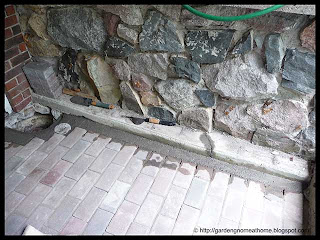Now that we have taken the house off the market we have decided to focus on getting a lot of projects done around the house. We moved here in June of 2007 and by October discovered drainage problems. In March of 2008 we had a major yard disruption to fix the drains running from the house to the municipal sewers. We had hoped that would solve our problems but we were wrong. In August of 2009 we had flooding in the house and by September of 2009 we had trenched from the house to the water's edge to completely correct the drainage problems. Essentially all of the storm drains and runoff run from the top of our property to the water. The slope of the property combined with a collapsed drainage system and improperly draining downspouts created erosion around the lower level of the house. When the trench was installed we were told to leave it to settle for a year. This past weekend my husband decided to repair where the trench had gone through on the lower patio.
The lower patio is inter laid pavers. This is not my ideal choice for paving in our area but it was the way the patio was when we bought the house. What happens is moisture gets into the ground then freezes causing the pavers to shift and buckle. Compounding the problem with drainage issues that resulted in more water than normal around this area cause more shifting. The patio pavers could easily be removed then the ground leveled out, resanded and the pavers replaced. We are debating doing this but we are also debating redoing the back to enclose the lower patio as well so until we are ready to do the retaining wall repairs we decided a temporary fix would work.
Once we leveled off the dirt from the opening we laid a nice layer of play sand. Pictured is the snd layer just as my husband started it. He used a board to level it. Sand acts as a bit of a cushion for the pavers. At the same time the sand fills the spaces between the pavers stopping them from shifting. Replacing the pavers was not difficult or even time consuming. We ended up with a few pavers left over. The reason being we decided not to cut pavers for the end section and not to pave over the pit. My husband reasoned that using cement would be a better solution that would give a bit more support while looking clean and finished. Most of the cement will be covered with potted plants as well so aesthetically it will look nice.
The fieldstone brick retainer walls at each end of the patio need to be redone. They have cracks from years of drainage issues that were ongoing well before we bought the house. The decision whether to fix or replace will be made when we decide whether or not we are redoing the upper sunporch and building in the lower level patio. The two spaces when redone would provide a considerable amount of solar heat in the winter !
My husband used hydraulic cement in the pit and quick set cement for the patch along the retainer wall and around the pit. The new drain cleanout is near the pit. It is hard to tell in the picture but he created a lowered edge around the pit so we can put a cover on it.
Once the cement had set up for 24 hours we started applying more play sand to fill in any cracks and crevices. Apparently a few earwigs were not very happy with this turn of events which pleased me somewhat because not they might move on elsewhere. Pictured is the section after the sand had been swept into the cracks for the first application. We intend to repeat the sand sweep in the fall and again in the spring to counteract any minor erosion that may occur over winter. We are keeping the extra pavers as well in case we simply decide to level the the lower patio.
It really is a bad time of year to be doing this type of work. The weather has been very hot and humid so the moisture seems to be lingering under the patio pavers. The patio gets very little direct sun so takes a long time to dry. The humidity has caused condensation around the cracks to in the morning it looks like the cracks are wet.
Garden Gnome
©2006-2010













0 comments:
Post a Comment